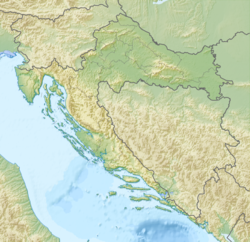
A | B | C | D | E | F | G | H | CH | I | J | K | L | M | N | O | P | Q | R | S | T | U | V | W | X | Y | Z | 0 | 1 | 2 | 3 | 4 | 5 | 6 | 7 | 8 | 9
Split
Spalato | |
|---|---|
| Grad Split City of Split | |
House of Vicka Nakića Bačvice Beach View of city at night | |
| Nickname: Velo misto (' big town') | |
| Anthem: Marjane, Marjane | |
| Coordinates: 43°30′36″N 16°26′24″E / 43.51000°N 16.44000°E | |
| Country | Croatia |
| County | Split-Dalmatia |
| Founded as Aspálathos | 3rd or 2nd century BCE |
| Diocletian's Palace built | 305 CE |
| Diocletian's Palace settled | 639 CE |
| Government | |
| • Type | Mayor-Council |
| • Mayor | Ivica Puljak (Centre) |
| • City Council | 31 members[1] |
| • Electoral district | 10th |
| Area | |
| • City | 79.4 km2 (30.7 sq mi) |
| • Urban | 23.1 km2 (8.9 sq mi) |
| Elevation | 0 m (0 ft) |
| Population (2021)[3] | |
| • City | 160,577 |
| • Density | 2,000/km2 (5,200/sq mi) |
| • Urban | 149,830 |
| • Urban density | 6,500/km2 (17,000/sq mi) |
| Time zone | UTC+1 (CET) |
| • Summer (DST) | UTC+2 (CEST) |
| Postal code | HR-21 000 |
| Area code | +385 21 |
| Vehicle registration | ST |
| Patron saint | Saint Domnius |
| Website | split |
| Official name | Historical Complex of Split with the Palace of Diocletian |
| Criteria | Cultural: (ii)(iii)(iv) |
| Reference | 97 |
| Inscription | 1979 (3rd Session) |
| Area | 20.8 ha (51 acres) |
Split (/ˈsplɪt/;[4][5] Croatian pronunciation: [splît] ); Italian: Spalato: pronounced [ˈspalato] see other names), is the second-largest city of Croatia after the capital Zagreb, the largest city in Dalmatia and the largest city on the Croatian coast. It lies on the eastern shore of the Adriatic Sea and is spread over a central peninsula and its surroundings. An intraregional transport hub and popular tourist destination, the city is linked to the Adriatic islands and the Apennine Peninsula. More than 900,000 tourists visit Split each year.[6]
The city was founded as the Greek colony of Aspálathos (Greek: Ἀσπάλαθος) in the 3rd or 2nd century BCE on the coast of the Illyrian Dalmatae, and in 305 CE, it became the site of the Palace of the Roman emperor Diocletian. It became a prominent settlement around 650 when it succeeded the ancient capital of the Roman province of Dalmatia, Salona. After the sack of Salona by the Avars and Slavs, the fortified Palace of Diocletian was settled by Roman refugees. Split became a Byzantine city. Later it drifted into the sphere of the Republic of Venice and the Kingdom of Croatia, with the Byzantines retaining nominal suzerainty. For much of the High and Late Middle Ages, Split enjoyed autonomy as a free city of the Dalmatian city-states, caught in the middle of a struggle between Venice and Croatia for control over the Dalmatian cities.
Venice eventually prevailed and during the early modern period Split remained a Venetian city, a heavily fortified outpost surrounded by Ottoman territory. Its hinterland was won from the Ottomans in the Morean War of 1699, and in 1797, as Venice fell to Napoleon, the Treaty of Campo Formio rendered the city to the Habsburg monarchy. In 1805, the Peace of Pressburg added it to the Napoleonic Kingdom of Italy and in 1806 it was included in the French Empire, becoming part of the Illyrian Provinces in 1809. After being occupied in 1813, it was eventually granted to the Austrian Empire following the Congress of Vienna, where the city remained a part of the Austrian Kingdom of Dalmatia until the fall of Austria-Hungary in 1918 and the formation of Yugoslavia. In World War II, the city was annexed by Italy, then liberated by the Partisans after the Italian capitulation in 1943. It was then re-occupied by Germany, which granted it to its puppet Independent State of Croatia. The city was liberated again by the Partisans in 1944, and was included in the post-war Socialist Yugoslavia, as part of its republic of Croatia. In 1991, Croatia seceded from Yugoslavia amid the Croatian War of Independence.
Name
The name Aspálathos or Spálathos may come from the spiny broom (Calicotome spinosa, ἀσπάλαθος in Greek),[7] although it is the related Spanish broom (Spartium junceum, σπάρτος) that is common in the area.
After the Roman conquest, the name became Spalatum or Aspalatum in Latin, which in the Middle Ages evolved into Aspalathum, Spalathum, Spalatrum and Spalatro in the Dalmatian language of the city's Romance population. From the Early modern period, in international correspondence and in all the city's official documents, the official name was the Latin Spalatum. The Venetian spelling, Spalato, became official in 18th century under Venetian rule and is still the name of the city in Italian.[8] From the 10th century onwards, the local use was Spaleto, from where, through a stage *Spəlētu- to *Splětъ, came the South Slavic forms: the ekavian Splet, ijekavian Spljet and ikavian Split.[8] In the 19th century, following the Illyrian movement and its official recognition by the Habsburg Monarchy, the Croatian names Split and Spljet became increasingly prominent, before Split officially replaced Spljet in 1910, by decision of the city council.[9]
Formerly, the name was thought to be related to Latin palatium 'palace', a reference to Diocletian's Palace. Various theories were developed, such as the notion that the name derives from S. Palatium, an abbreviation of Salonae Palatium. The erroneous "palace" etymologies were notably due to Byzantine Emperor Constantine VII Porphyrogenitus, and were later mentioned by Thomas the Archdeacon.[10] The city, however, is several centuries older than the palace.
History
Antiquity

Although the beginnings of Split are traditionally associated with the construction of Diocletian's Palace in 305, the city was founded several centuries earlier as the Greek colony of Aspálathos, or Spálathos. It was a colony of the polis of Issa, the modern-day town of Vis, itself a colony of the Sicilian city of Syracuse.[11] The exact year the city was founded is not known, but it is estimated to have been in the 3rd or 2nd century BC.[12] The Greek settlement lived off trade with the surrounding Illyrian tribes, mostly the Delmatae.[11]
After the Illyrian Wars of 229 and 219 BC, the city of Salona, only a short distance from Spálathos, became the capital of the Roman Province of Dalmatia and one of the largest cities of the late empire with 60,000 people. The history of Spálathos becomes obscure for a while at this point, being overshadowed by that of nearby Salona, to which it would later become successor. The Roman Emperor Diocletian (ruled AD 284 to 305) in 293 began the construction of an opulent and heavily fortified palace fronting the sea, near his home town of Salona, selecting the site of Spálathos (or Spalatum in Latin).[13][14] The Palace was built as a massive structure, much like a Roman military fortress. The palace and the city of Spalatum which formed its surroundings were at times inhabited by a population as large as 8,000 to 10,000 people.[15]
Between 475 and 480, the Palace hosted Flavius Julius Nepos, the last recognised Emperor of the Western Roman Empire. Salona was lost to the Ostrogothic Kingdom in 493, along with most of Dalmatia, but the Emperor Justinian I regained Dalmatia in 535–536.

Middle Ages
The Pannonian Avars sacked and destroyed Salona in 639; the surviving Romans fled to the nearby islands. The Dalmatian region and its shores were at this time settled by tribes of Croats, a South Slavic people subservient to the Avar khagans.[16] The Salonitans regained the land under Severus the Great in 650 and settled the 300-year-old Palace of Diocletian, which could not be effectively besieged by the Slavic tribes of the mainland.[16] The Emperor Constans II granted them an Imperial mandate to establish themselves in the Palace as the City of Spalatum, which imposed upon the Croatian Slavs - at the time allies of Byzantium against the Avars - a cessation of hostilities.[16] The Temple of Jupiter was rededicated to the Virgin Mary and the remains of the popular Saint Domnius were recovered from the ruins of Salona, later establishing the Cathedral of Saint Domnius as new seat of the Archbishop of Salona.[16]
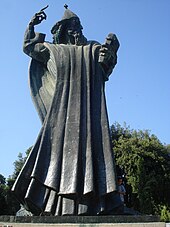
Until the Sack of Constantinople, Split remained a de jure possession of the Byzantine Empire as a Byzantine duchy, administered by the Exarchate of Ravenna and after 751 by Jadera (Zadar).[17] Its hinterland, however, was now home to the Duchy of the Croats. In this period, an independent Dalmatian language developed from Latin, with a distinct local dialect: to its inhabitants, the city became known as Spalatrum or Spalatro, one of the main Dalmatian city-states.
In 925, Tomislav's Kingdom of Croatia emerged in the hinterland of the city, centered in Nin as an ally of Byzantium against Simeon I of Bulgaria - though without receiving any power from the Emperor over the Dalmatian cities.[17] The rise of the rival Bishopric of Nin, headed by Bishop Gregory, which attempted to institute the "Slavonic" or "Slavic language" as the language of religious service, led to the 925 Synod of Split, at which it was decreed that "no one should presume to celebrate the divine mysteries in the Slavonic language, but only in Latin and Greek, and that no one of that tongue should be advanced to the holy orders".
Medieval overlords of Split, 998–1420 | ||||||||||||||||
980 — – 1000 — – 1020 — – 1040 — – 1060 — – 1080 — – 1100 — – 1120 — – 1140 — – 1160 — – 1180 — – 1200 — – 1220 — – 1240 — – 1260 — – 1280 — – 1300 — – 1320 — – 1340 — – 1360 — – 1380 — – 1400 — – 1420 — – 1440 — | ||||||||||||||||
In 1100, the bell tower which became the main symbol of the city was constructed and dedicated to Saint Domnius, by then regarded as the patron saint of the city.
Throughout the 9th and 10th centuries, Split was raided by the Narentines (a South Slavic confederation recognizing the King of Croatia as their sovereign). Therefore, the city offered its allegiance to Venice and in 998 the Venetian Doge Pietro II Orseolo, led a large naval expedition which defeated the Narentines the same year. After obtaining permission from Emperor Basil II in Constantinople, Orseolo proclaimed himself Duke of Dalmatia. In 1019 the Byzantine Empire restored direct control over Dalmatia. The title "Duke of Dalmatia" seems to have been dropped at this point by the Venetian doges. In 1069 Peter Krešimir IV, King of Croatia, gained control over Dalmatian islands and cities, including Split, and stretched his rule south to Neretva. The coastal cities retained autonomous administration and were still nominally under Byzantine Empire, but were now subjects of the Croatian king.[18][19][20]
After the death of Croatian King Stephen II in 1091, a period of succession crisis followed in Croatia, with King Ladislaus I of Hungary interfering in it.[21] Byzantine Emperor Alexius took advantage of this and joined the old Theme of Dalmatia to the Empire.[19][22] In 1096 Emperor Alexius, at the time engaged in the First Crusade, granted the administration of Dalmatia to the Doge of Venice.[22]
In 1105, Coloman, King of Hungary, having conquered the Kingdom of Croatia, reneged on its alliance with Venice and moved on the coastal towns, besieging and taking Zadar. Split and Trogir decided then to surrender upon guarantee of their ancient privileges.[16] The rights granted to the city (and reaffirmed by new charters) were substantial. Split was to pay no tribute, it was to choose its own count and archbishop whom the king would confirm, it preserved its old Roman laws, and appointed its own judge. Dues from trade (which were substantial in the period), were divided between the count, the archbishop, and the king, and no foreigner was to live within the walls of the city against the will of the citizens. These rights were generally upheld by Hungarian kings, but there were inevitable incidents of violation.
After Coloman's death in 1116, the Doge Ordelafo Faliero returned from Outremer and retook all the Dalmatian cities, and also, for the first time, the Croatian cities of coast such as Biograd and Šibenik. In 1117, however, he was defeated and killed in renewed battle with the Hungarians under Stephen II of Hungary, and Split again acknowledged Hungarian rule. But the new Doge, Domenico Michiel, quickly defeated the Hungarians again and restored Venetian authority by 1118. In 1124, while the Doge was engaged against the Byzantine Empire (now hostile to Venice), Stephen II recovered Split and Trogir without resistance. Upon Michele's return in 1127, however, the Doge yet again expelled the Hungarians from the two cities and utterly destroyed Biograd, the favored seat of the Croatian Kings that the Hungarians were attempting to establish as a rival to the Venetian Zadar.[16]
The cities remained in Venetian hands without contest during the reign of Béla II. But in 1141, his successor, King Géza II, having conquered Bosnian lands, marched to Split and Trogir, both voluntarily accepting him as overlord. This turned out to be a definitive conquest, as Venetian rule was not to return to Split for another 186 years.
In that period, however, Split was to see one brief (and final) restoration of Imperial power in Dalmatia. The Byzantine Emperor Manuel I Comnenus began his campaigns against the Kingdom of Croatia and Hungary in 1151, and by 1164, had secured the submission of the Dalmatian cities back under Imperial rule. Having won a decisive victory against Kingdom of Croatia and Hungary in 1167 at the Battle of Sirmium, consolidating his gains, the Emperor suddenly broke with Venice as well, and sent a fleet of 150 ships to the Adriatic. Split was to remain in Byzantine hands until Manuel's death in 1180, when Béla III of Hungary moved to restore Hungarian power in Dalmatia. The city remained loyal to the Empire, resisting the re-establishment of Hungarian rule, and consequently, upon its inevitable submission, was punished with the King's refusal to renew its ancient privileges.[16]
During the 20-year Hungarian civil war between King Sigismund and the Capetian House of Anjou of the Kingdom of Naples, the losing contender, Ladislaus of Naples, sold his disputed rights on Dalmatia to the Venetian Republic for 100,000 ducats. Acting on the pretext, the Republic took over in the city by the year 1420.[23]
Venetian period
By this time the population was largely Croatian,[24] while Romance Dalmatian names were not as common,[25] according to the Medieval city archives. The common language was Croatian, but a variety of the Venetian language with some Tuscan influences was also widely spoken by Dalmatian Italian notaries, school teachers, merchants, and officials.[26] The city's autonomy was greatly reduced: the highest authority was a prince and captain (conte e capitanio), assigned by Venice.[27]
Split eventually developed into a significant port-city, with important trade routes to the Ottoman-held interior through the nearby Klis pass. Culture flourished as well, Split being the hometown of Marko Marulić, the Croatian national poet. Marulić's most acclaimed work, Judita (1501), was an epic poem about Judith and Holofernes, widely held to be the first modern work of Croatian literature. It was written in Split and printed in Venice in 1521.[28]
The advances and achievements were reserved mostly for the aristocracy: the illiteracy rate was extremely high, mostly because Venetian rule showed little interest in educational and medical facilities.[citation needed]
In 1797, Split was ceded to the Habsburg monarchy by the Treaty of Campo Formio, as part of the dissolution and partition of the ancient Republic of Venice.[29]
Napoleonic wars
Split became part of the Napoleonic Kingdom of Italy in 1805, after the defeat of the Third Coalition at the Battle of Austerlitz and the consequent Treaty of Pressburg. It was included directly in the French Empire in 1806. The same year, Vincenzo Dandolo was named provveditore generale and general Auguste de Marmont was named military commander of Dalmatia.[30]
In 1809, after a brief war with France, Austria ceded Carinthia, Carniola, Croatia west of the Sava River, Gorizia and Trieste to France. These territories, along with Dalmatia, formed the Illyrian Provinces. During this period, large investments were undertaken in the city, new streets were built and parts of the ancient fortifications were removed.[31][32] Austria, with help from a British force led by Captain William Hoste, occupied Split in November 1813.[33] Following the Congress of Vienna in 1815, the city was officially ceded to Austria.[34]
Under Habsburg rule
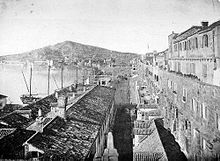

The Split region became part of the Kingdom of Dalmatia, a separate administrative unit. After the revolutions of 1848 as a result of the romantic nationalism, two factions appeared. One was the pro-Croatian Unionist faction (later called the "Puntari", "Pointers"), led by the People's Party and, to a lesser extent, the Party of Rights, both of which advocated the union of Dalmatia with the Kingdom of Croatia-Slavonia which was under Hungarian administration. This faction was strongest in Split, and used it as its headquarters. The other faction was the pro-Italian Autonomist faction (also known as the "Irredentist" faction), whose political goals varied from autonomy within the Austro-Hungarian Empire, to a political union with the Kingdom of Italy.
The political alliances in Split shifted over time. At first, the Unionists and Autonomists were allied against the centralism of Vienna. After a while, when the national question came to prominence, they separated. Under Austria, however, Split can generally be said to have stagnated. The great upheavals in Europe in 1848 gained no ground in Split, and the city did not rebel.
Antonio Bajamonti became Mayor of Split in 1860 and – except for a brief interruption during the period 1864–65 – held the post for over two decades until 1880. Bajamonti was also a member of the Dalmatian Sabor (1861–91) and the Austrian Chamber of Deputies (1867–70 and 1873–79). In 1882 Bajamonti's party lost the elections and Dujam Rendić-Miočević, a prominent city lawyer, was elected to the post.
As part of Yugoslavia
Kingdom of Yugoslavia
After the end of World War I and the dissolution of Austria-Hungary, the province of Dalmatia, along with Split, became a part of the Kingdom of Serbs, Croats and Slovenes. Split was the site of a series of incidents between 1918 and 1920. Since Rijeka, Trieste and Zadar, the three other large cities on the eastern Adriatic coast, were annexed by Italy, Split became the most important port in the Kingdom. The Lika railway, connecting Split to the rest of the country, was completed in 1925. The country changed its name to the Kingdom of Yugoslavia in 1929, and the Port of Split became the seat of new administrative unit, Littoral Banovina. After the Cvetković-Maček agreement, Split became the part of new administrative unit (merging of Sava and Littoral Banovina plus some Croat populated areas), Banovina of Croatia in the Kingdom of Yugoslavia.
World War II
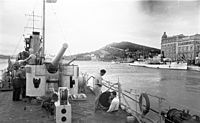

In April 1941, following the invasion of Yugoslavia by Nazi Germany, Split was occupied by Italy. Although Split formally became part of the Independent State of Croatia, the Ustaše were not able to establish and strengthen their rule in Split, as Italians assumed all power in Dalmatia. One month later on 18 May 1941, when the Treaties of Rome were signed, Italy formally annexed Split, which was included in the province of Spalato, and large parts of Dalmatia down to Kotor.[35][36] The Italian Governatorate of Dalmatia hosted 390,000 inhabitants, of which 280,000 Croats, 90,000 Serbs and 5,000 Dalmatian Italians.[37] Italian rule met heavy opposition from the Croat population as Split became a centre of anti-fascist sentiment in Yugoslavia. The first armed resistance group was organized on 7 May 1941; the 63 member strong 1st Strike Detachment (Prvi udarni odred) served as the basis for future formations, including the 1st Split Partisan Detachment.[38] Between September and October 1941 alone, ten officials of the Italian fascist occupation were assassinated by the citizens.[39] On 12 June 1942, a fascist mob attacked the city's synagogue, and destroyed its library and archive. Worshipers were beaten as they left the synagogue and Jewish-owned shops were targeted the following day.[40] The local football clubs refused to compete in the Italian championship; HNK Hajduk and RNK Split suspended their activities and both joined the Partisans along with their entire staff after the Italian capitulation provided the opportunity. Soon after Hajduk became the official football club of the Partisan movement.
In September 1943, following the capitulation of Italy,[37] the city was temporarily controlled by Tito's brigades with thousands of people volunteering to join the Partisans of Marshal Josip Broz Tito (a third of the total population, according to some sources). Eight thousand Italian soldiers from the 15th Infantry Division Bergamo prepared to fight alongside the Yugoslav Partisans against the Waffen SS Prinz Eugen. The Italian General Becuzzi handed over to the Partisans 11 soldiers which they considered as "war criminals;[citation needed] the Partisans also executed up to 41 members of the Italian Police forces, later found in mass graves.[41][relevant?]
A few weeks later, however, the Partisans were forced into retreat as the Wehrmacht placed the city under the authority of the Independent State of Croatia. The Germans decimated the Italian soldiers as traitors, including three Generals (Policardi, Pelligra and Cigala Fulgosi) and 48 officials (Trelj massacre).[42] In this period the last remaining symbols of Italian heritage in Split, including several Venetian Lions of St. Mark, were erased from the town.
In a tragic turn of events, besides being bombed by Axis forces, the city was also bombed by the Allies, causing hundreds of deaths. Partisans finally captured the city on 26 October 1944 and instituted it as the provisional capital of Croatia. On 12 February 1945, the Kriegsmarine conducted a daring raid on the Split harbour, damaging the British cruiser Delhi. After the war the remaining members of Dalmatian Italians of Split left Yugoslavia towards Italy (Istrian-Dalmatian exodus).[43]
Federal Yugoslavia
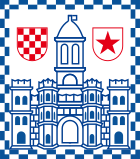
After World War II, Split became a part of the Socialist Republic of Croatia, itself a constituent sovereign republic of the Socialist Federal Republic of Yugoslavia. During the period the city experienced its largest economic and demographic boom. Dozens of new factories and companies were founded with the city population tripling during the period. The city became the economic centre of an area exceeding the borders of Croatia and was flooded by waves of rural migrants from the undeveloped hinterland who found employment in the newly established industry, as part of large-scale industrialization and investment by the Yugoslav Federal Government.[citation needed]
The shipbuilding industry was particularly successful and Yugoslavia, with its Croatian shipyards, became one of the world's top nations in the field. Many recreational facilities were also constructed with federal funding, especially for the 1979 Mediterranean Games, such as the Poljud Stadium. The city also became the largest passenger and military port in Yugoslavia, housing the headquarters of the Yugoslav Navy (Jugoslavenska ratna mornarica, JRM) and the Army's Coastal Military District (equivalent of a field army). In the period between 1945 and 1990, the city was transformed and expanded, taking up the vast majority of the Split peninsula. In the same period it achieved an as yet unsurpassed GDP and employment level, still above the present day's, growing into a significant Yugoslav city.[citation needed]
Since independence

When Croatia declared its independence again in 1991, Split had a large garrison of Yugoslav People's Army (JNA) troops (drafted from all over Yugoslavia), as well as the headquarters and facilities of the Yugoslav Navy (JRM). This led to a tense months-long stand-off between the JNA and Croatian National Guard and police forces, occasionally flaring up in various incidents. The most tragic incident occurred on 15 November 1991, when the JRM light frigate Split fired a small number of shells at the city and its surroundings. The damage was insignificant but there were a few casualties. Three general locations were bombarded: the old city center, the city airport, and an uninhabited part of the hills above Kaštela, between the airport and Split. JRM sailors, most of them Croats themselves, who had refused to attack Croat civilians were left in the vessel's brig. The JNA and JRM evacuated all of its facilities in Split during January 1992. The 1990s economic recession soon followed.
In the years following 2000, Split finally gained momentum and started to develop again, with a focus on tourism. From being just a transport centre, Split is now a major Croatian tourist destination. Many new hotels are being built, as well as new apartment and office buildings. Many large development projects are being revived, and new infrastructure is being built. An example of one of the latest large city projects is the Spaladium Arena, built in 2009.
Geography
Split is situated on a peninsula between the eastern part of the Gulf of Kaštela and the Split Channel. The Marjan hill (178 m (584 ft)), rises in the western part of the peninsula. The Kozjak (779 m (2,556 ft)) and Mosor (1,339 m (4,393 ft)) ridges protect the city from the north and northeast, and separate it from the hinterland.
Split is administratively divided into 34 city kotars:[44][45]
Climate

Split has a Mediterranean climate (Csa) in the Köppen climate classification. It experiences hot, moderately dry summers and mild, wet winters, which can occasionally feel cold, because of a strong northern wind, termed bura.
January is the coldest month, with an average low temperature around 6 °C (43 °F). July is the hottest month, with an average high temperature around 31 °C (88 °F). Average annual rainfall is around 800 mm (31.50 in). November is the wettest month, with a precipitation total of nearly 120 mm (4.72 in) and 12 rainy days. July is the driest month, with a precipitation total of around 25 mm (0.98 in). Snow is usually rare, though in February 2012, during cold wave in Europe, Split received a record snowfall of 25 cm (9.84 in), which caused major problems with traffic.[46][47] Split receives more than 2,600 sunshine hours annually.
In July 2017, Croatian firefighters battled to control a forest fire along the Adriatic coast that damaged and destroyed buildings in villages around the city of Split.


| Climate data for Split (Marjan Hill, 1991–2020, extremes 1948–2019) | |||||||||||||
|---|---|---|---|---|---|---|---|---|---|---|---|---|---|
| Month | Jan | Feb | Mar | Apr | May | Jun | Jul | Aug | Sep | Oct | Nov | Dec | Year |
| Record high °C (°F) | 17.4 (63.3) |
22.3 (72.1) |
24.3 (75.7) |
27.7 (81.9) |
33.2 (91.8) |
38.1 (100.6) |
38.6 (101.5) |
38.5 (101.3) |
34.2 (93.6) |
27.9 (82.2) |
25.8 (78.4) |
18.6 (65.5) |
38.6 (101.5) |
| Mean daily maximum °C (°F) | 10.7 (51.3) |
11.5 (52.7) |
14.5 (58.1) |
18.4 (65.1) |
23.4 (74.1) |
28.1 (82.6) |
31.0 (87.8) |
30.9 (87.6) |
25.4 (77.7) |
20.5 (68.9) |
15.6 (60.1) |
11.8 (53.2) |
20.2 (68.3) |
| Daily mean °C (°F) | 8.2 (46.8) |
8.7 (47.7) |
11.3 (52.3) |
14.9 (58.8) |
19.7 (67.5) |
24.2 (75.6) |
26.8 (80.2) |
26.8 (80.2) |
21.7 (71.1) |
17.4 (63.3) |
13.1 (55.6) |
9.4 (48.9) |
16.8 (62.3) |
| Mean daily minimum °C (°F) | 5.9 (42.6) |
6.0 (42.8) |
8.5 (47.3) |
11.8 (53.2) |
16.1 (61.0) |
20.2 (68.4) |
22.8 (73.0) |
22.9 (73.2) |
18.4 (65.1) |
14.7 (58.5) |
10.8 (51.4) |
7.2 (45.0) |
13.8 (56.8) |
| Record low °C (°F) | −9.0 (15.8) |
−8.1 (17.4) |
−6.6 (20.1) |
0.3 (32.5) |
4.8 (40.6) |
9.1 (48.4) |
13.0 (55.4) |
11.2 (52.2) |
8.8 (47.8) |
3.8 (38.8) |
−4.5 (23.9) |
−6.3 (20.7) |
−9.0 (15.8) |
| Average precipitation mm (inches) | 72.7 (2.86) |
63.8 (2.51) |
58.4 (2.30) |
62.0 (2.44) |
57.8 (2.28) |
49.2 (1.94) |
24.6 (0.97) |
31.7 (1.25) |
82.3 (3.24) |
79.6 (3.13) |
119.8 (4.72) |
98.7 (3.89) |
800.6 (31.53) |
| Average precipitation days (≥ 0.1 mm) | 10.5 | 9.4 | 9.6 | 10.4 | 9.4 | 7.8 | 5.1 | 4.6 | 8.2 | 9.3 | 11.7 | 11.9 | 107.9 |
| Average snowy days | 0.3 | 0.6 | 0.3 | 0 | 0 | 0 | 0 | 0 | 0 | 0 | 0.1 | 0.2 | 1.5 |
| Average relative humidity (%) | 61
Zdroj:https://en.wikipedia.org?pojem=Aspálathos Text je dostupný za podmienok Creative Commons Attribution/Share-Alike License 3.0 Unported; prípadne za ďalších podmienok. Podrobnejšie informácie nájdete na stránke Podmienky použitia.
Analytika
Antropológia Aplikované vedy Bibliometria Dejiny vedy Encyklopédie Filozofia vedy Forenzné vedy Humanitné vedy Knižničná veda Kryogenika Kryptológia Kulturológia Literárna veda Medzidisciplinárne oblasti Metódy kvantitatívnej analýzy Metavedy Metodika Text je dostupný za podmienok Creative
Commons Attribution/Share-Alike License 3.0 Unported; prípadne za ďalších
podmienok. www.astronomia.sk | www.biologia.sk | www.botanika.sk | www.dejiny.sk | www.economy.sk | www.elektrotechnika.sk | www.estetika.sk | www.farmakologia.sk | www.filozofia.sk | Fyzika | www.futurologia.sk | www.genetika.sk | www.chemia.sk | www.lingvistika.sk | www.politologia.sk | www.psychologia.sk | www.sexuologia.sk | www.sociologia.sk | www.veda.sk I www.zoologia.sk | ||||||||||||










